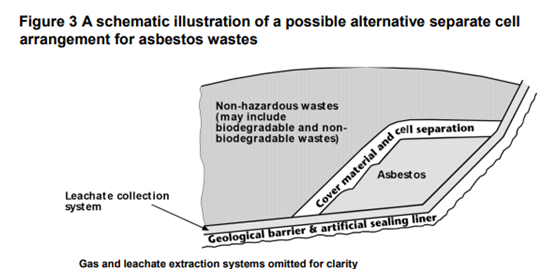Stabilised Non-Reactive Hazardous Waste
A Non-Hazardous Landfill can receive Stabilised Non-Reactive Hazardous Waste (SNRHW) if certain criteria are met, including acceptance limits and the requirement that any cell which receives this material is separated from cells receiving Biodegradable Waste. This includes Gypsum waste and high Sulphate waste (such as Plasterboard) within acceptance limits to prevent the 'unacceptable emissions of hydrogen sulphide gas'. If the acceptance limits for 'high sulphate bearing wastes' are exceeded then the material must go to a Hazardous Landfill.
The most recent UK guidance on the Landfill Directive and the Landfill of Stabilised Non-Reactive Hazardous Waste that sets out the requirements is LFD1 Understanding the Landfill Directive[1] is published by the EA and referred to by the other regulatory bodies in the UK.
Two figures for possible separation of cells are included in the guidance and are repeated below:
 |
 |
Asbestos Waste can be deposited in a separate cell, but only if it is sufficiently self contained and designed not to be disturbed in the future, as shown in the following figure from the guidance:
 |
Capacity Non-Hazardous Landfill with Stabilised Non-Reactive Hazardous Waste
The capacity of Non-Hazardous Landfill which has a cell or cells for Stabilised Non-Reactive Hazardous Waste is also reported by the EA and is summarised in the graph and table below (although the proportion of the total which is Stabilised Non-Reactive Hazardous Waste is generally relatively small). Note that Hazardous Landfill also provides Inert Landfill capacity in the sense that these waste are used for daily cover and site engineering purposes.
The number of Non-Hazardous Landfill with a SNRHW cell (ref. L02) sites in England in 2020 was 30, an increase of 1 on 2019.
| <graph>{
"width":400, "height":200, "data":[{ "name":"table", "values":[ {"x":2015,"y":89.4},{"x":2016,"y":85.3},{"x":2017,"y":82.9}, {"x":2018,"y":75.1},{"x":2019,"y":69.4},{"x":2020,"y":67.0} ] }], "scales": [ {
"name": "x",
"type": "linear",
"range": "width",
"zero": false,
"domain": {"data": "table", "field": "x"}
},
{
"name": "y",
"type": "linear",
"range": "height",
"nice": true,
"domain": {"data": "table", "field": "y"}
}
], "axes": [ {"type": "x", "scale": "x", "format":"d","title":"Year"},
{"type": "y", "scale": "y", "grid":true, "title":"Million Cubic Metres"}
], "marks": [ {
"type": "line",
"from": {"data": "table"},
"properties": {
"enter": {
"x": {"scale": "x", "field": "x"},
"y": {"scale": "y", "field": "y"},
"stroke": {"value": "steelblue"},
"strokeWidth":{"value":2}
}
}
},
{ "type": "symbol",
"from": {"data": "table"},
"properties": {
"enter": {
"x": {"scale":"x","field": "x"},
"y": {"scale":"y","field": "y"},
"fill": {"value": "steelblue"},
"size":{"value":15}
}
}
} ] }</graph> |
| Year | 2015 | 2016 | 2017 | 2018 | 2019 | 2020 |
| Million Cubic Metres | 89.4 | 85.3 | 82.9 | 75.1 | 69.4 | 67.0 |
